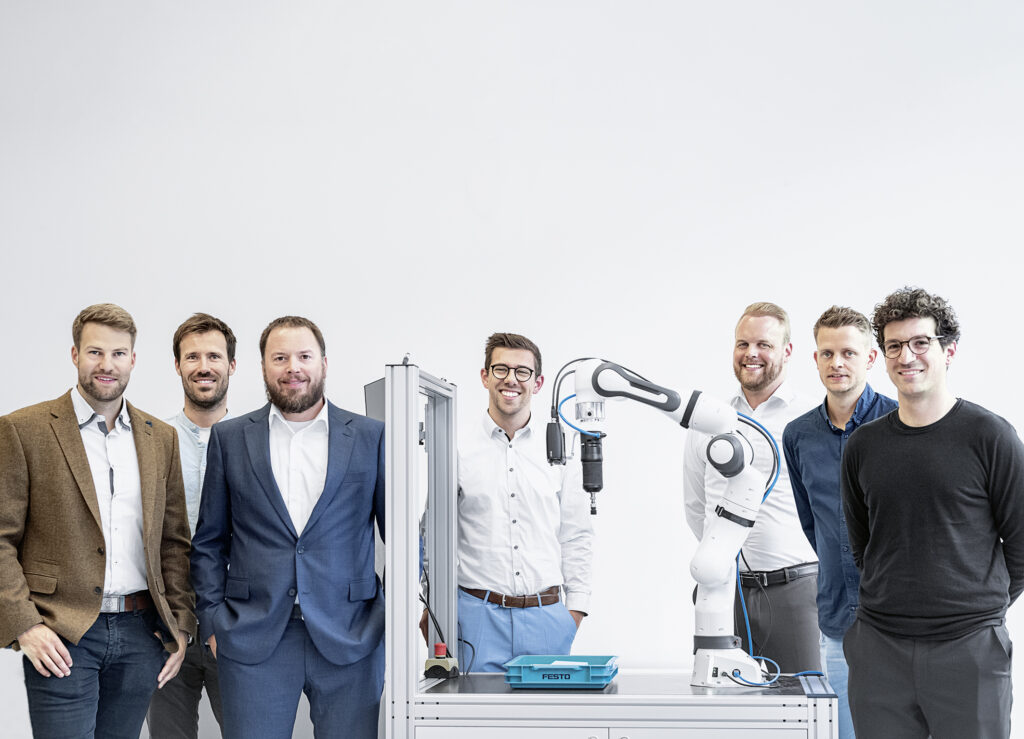
Distributed AI method improves efficiency of picking robot training
August 4, 2023
By Manufacturing AUTOMATION
Successful FLAIROP research project proves possibility of using efficient AI to enhance robot learning capabilities without exchange of sensitive data.
 The FLAIROP research team from left to right: Kai Sandmann (German Federal Ministry for the Economy and Climate Protection), Maximilian Brock (DLR), Daniel Brauchle (Advanced Development Artificial Intelligence, Festo), Florian Leiser (Project Team KIT), Jan Seyler (Head of Advanced Development Analytics and Control, Festo), Sascha Rank (Project Manager KIT), Maximilian Gilles (Project Manager KIT).
(Photo source: Festo)
The FLAIROP research team from left to right: Kai Sandmann (German Federal Ministry for the Economy and Climate Protection), Maximilian Brock (DLR), Daniel Brauchle (Advanced Development Artificial Intelligence, Festo), Florian Leiser (Project Team KIT), Jan Seyler (Head of Advanced Development Analytics and Control, Festo), Sascha Rank (Project Manager KIT), Maximilian Gilles (Project Manager KIT).
(Photo source: Festo) Festo announced the successful completion of the FLAIROP (Federated Learning for Robot Picking) research project that was aimed at making picking robots more intelligent using distributed AI methods.
Festo has been conducting joint research with the “Karlsruher Institut für Technologie” (KIT) and partners from Canada – University of Waterloo and Darwin AI. The partners investigated how robots can learn from each other without sharing their training data. This approach – called “federated learning” – allows to develop more robust and efficient AI than it would be possible with data from just one robot – without handing out sensitive company data. At the completion of the project, all project participants – as well as the interested public – were on site in Esslingen-Berkheim, Germany, or presented their results live from Canada.
Festo explains in a press statement that “federated learning” is a machine learning technique to create privacy-preserving AI applications. Instead of sending the training data of the robotic arms in the picking cells to a central server to train the model there, the training takes place at many different locations. The locally trained models are then sent to the central machine learning server so that the sensitive training data does not leave the data provider. “Federated learning” reportedly enables learning across data silos by aggregating the distributed models and enabling highly accurate and data-driven prediction of object recognition and grasping point detection.
The robot arms in the picking cells are equipped with cameras to visually detect the items in front of them. Based on the camera image, the robot arms automatically recognize the different items and select a suitable gripping method. Due to the variety of items in a warehouse, this is a complicated task and large amounts of data are needed to achieve reasonable results. Creating such large amounts of data is time-consuming. With data collected from picking cells in different organizations, it was possible to improve the grasping point detection of the cells.
“We have developed a universal, simulation-based data set that we can use to train autonomous gripping robots in such a way that they are able to reliably grasp items that they have not seen before,” explains Maximilian Gilles from KIT.
During the project, a total of five autonomous picking stations were set up for training the robots: two at the KIT Institute for Materials Handling and Logistics Systems (IFL) and three at Festo SE & Co. KG based in Esslingen am Neckar. At the final event, Festo focused on the usability of the results. The research results will now be published and can be freely used by all interested parties in initial pilot projects.
Advertisement
- Inductive Automation launches Alliance Partner Program, names first partner companies
- IIC adds the Smart Cyber Group as its newest member